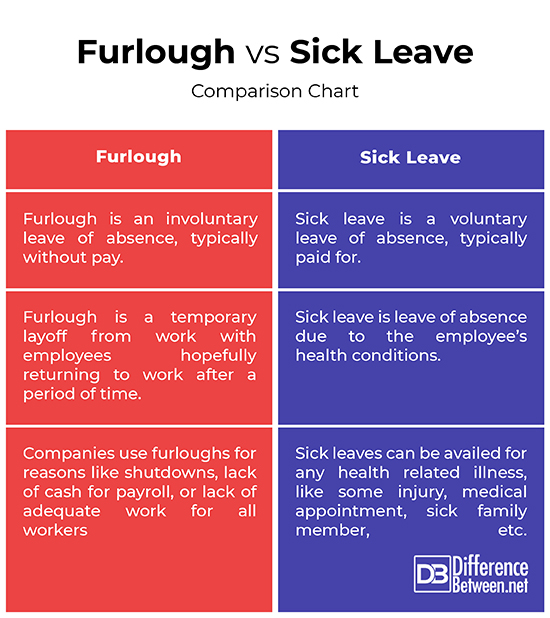Difference Between Furlough and Sick Leave
Millions of people have been furloughed or laid off from work during the COVID-19 pandemic as companies are implementing measures to ensure their financial stability and get back on track. The furlough scheme has protected millions of jobs during the pandemic, especially in the UK where the employers have been offered government grants to cover 80% of wages for employees on their payroll. This begs the question: what exactly is a furlough? And how is it any different than a sick leave?

What is Furlough?
The term furlough means an authorized leave of absence granted to an employee due to special needs of the company or the employer. It is a temporary leave of absence from which the employees are expected to return to work after a brief period of time. Being furloughed is not the same as being fired; you may be required to take certain number of unpaid hours off for weeks or for months, for any number of reasons. Companies use furloughs for reasons like shutdowns, lack of cash for payroll, or lack of adequate work for all workers.
Furlough is an involuntary leave or some modification in work hours, like a temporary layoff from work and companies use these to get through difficult times financially. So, you remain their employees but not getting paid. You’re off the books from their payroll but entitled to get some benefits. It is a temporary measure, with employees hopefully returning to work after a period of time. The employer will have to notify you first of their intention to furlough you.

What is a Sick Leave?
Sick leave is leave of absence due to the employee’s health conditions. Employees are entitled to sick leave or paid sick leave if they or any member of their family are sick or suffered from any form of illness. Sick leave with pay may be granted to employees by the executive departments or independent establishment, within the limits as per the law. Sick leave is usually allotted to employees to attend to their health needs or the needs of a sick family member. Sick leaves can be paid or unpaid.
Paid sick leave is a voluntary benefit provided by employers for long-term or short-term health needs, depending on the company and state laws. The entire amount of sick leave authorized by the company may be granted at one time or fractionally. More than 90% of the government employees receive paid sick leaves, while over 70% of the private sector employees are offered this benefit. High pay grade employees typically receive more paid sick leaves than their low-paid counterparts.
Difference between Furlough and Sick Leave
Meaning
– Furlough is an involuntary leave of absence, typically without pay, where the employers choose to temporary pause employment but the employees are expected to return to work after a certain period of time as prescribed by the company. Sick leave is paid absence from work specifically to recover from some illness or attend to the needs of a sick family member. It is a voluntary leave of absence where you can choose to stay at home to address your health needs without losing pay.
Reason
– Furloughs are quite common in the private sector where the companies are forced to do so for many number of reasons. Companies use furloughs as a staffing reduction strategy for reasons like shutdowns, lack of cash for payroll, or lack of adequate work for all workers. Furloughs are usually implemented by employers and are involuntary to the employees. Sick leaves can be availed for any health related illness, like some injury, medical appointment, sick family member, operation, hospital stay, etc.
Limit
– There is no specific time limit on how long a company is supposed to furlough an employee with or without pay, as long as the employees are eligible for furlough. Typically furloughs can last for a few weeks or few months, but no more than 12 months. When it comes to sick leaves, the employees are typically entitled to a maximum of 12 days of paid sick leaves or more depending on the establishment and the account of sickness. Well, the definition of sick leave and law differs from company to company.
Furlough vs. Sick Leave: Comparison Chart

Summary
While a furlough and a sick leave may sound similar for some reasons, they are very different. Furlough is a temporary layoff kind of situation where the companies choose to temporary pause the employment for some financial reasons, like plant shutdowns, cash deficiency, or lack of work. Furloughs are more common in the private sector and are mandatory leaves of absence without pay. Sick leave is a voluntary leave of absence granted to employees of almost every organization on the grounds of health-related illness for self or an immediate family member.
How do I write a sick leave?
A sick leave letter should be clearly written in a polite manner that states the request and reason for leave, typically with the doctor’s note attached. If you know for sure how many days you will be on sick leave, then you should specify that too.
What is the best reason for sick leave?
Sick leaves can only be availed on the grounds of health-related illness for self or an immediate family member.
How long is a sick leave in Ontario?
Employees are entitled to a maximum of three unpaid sick leave days each calendar year on medical grounds.
What does sick leave mean?
Sick leave means a voluntary leave of absence provided by employers for long-term or short-term health needs of the employee, depending on the company and state laws. Sick leaves are mostly paid.
- Difference Between Caucus and Primary - June 18, 2024
- Difference Between PPO and POS - May 30, 2024
- Difference Between RFID and NFC - May 28, 2024
Search DifferenceBetween.net :
Leave a Response
References :
[0]Hughes, James J. and Richard Perlman. The Economics of Unemployment: A Comparative Analysis of Britain and the United States. Cambridge, United Kingdom: Cambridge University Press, 1984. Print
[1]O’Donnell, Riia. “What Is Sick Leave? Plus 3 Things Every Sick Leave Policy Needs.” Zenefits, 21 April 2021, www.zenefits.com/workest/what-is-sick-leave-plus-3-things-every-sick-leave-policy-needs/. Accessed 28 April 2022.
[2]“Furlough.” Wikipedia, Wikimedia Commons, 3 April 2022, https://en.wikipedia.org/wiki/Furlough. Accessed 28 April 2022.
